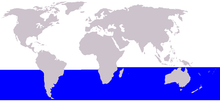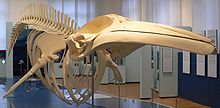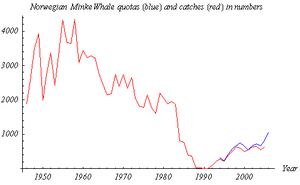- Common minke whale
-
Common minke whale[1] 
Lithography by Bocourt 
Size comparison against an average human Conservation status Scientific classification Kingdom: Animalia Phylum: Chordata Class: Mammalia Subclass: Eutheria Order: Cetacea Suborder: Mysticeti Family: Balaenopteridae Genus: Balaenoptera Species: B. acutorostrata Binomial name Balaenoptera acutorostrata
Lacepede, 1804
Common minke whale range 
Dwarf minke whale range The common minke whale or northern minke whale, (Balaenoptera acutorostrata), is a species of minke whale within the suborder of baleen whales.
Contents
Taxonomy
The common minke whale was first identified by Lacepede in 1804.[3] There are several forms of common minke whale, including Scammon's minke whale (B. a. scammoni) from the North Pacific and the dwarf minke whale, from the Southern Hemisphere.[3]
Until recently, all minke whales were considered a single species. However, the common minke whale was recognized as a separate species from the Antarctic minke whale based on mitochondrial DNA testing.[4] This testing also confirmed that the Antarctic minke whale is the closest relative of the common minke whale, thus confirming the validity of the minke whale clade[4]
Description
The common minke whale is the smallest of the rorquals, and one of the smallest baleen whales (second smallest only to the Pygmy Right Whale). Except for the dwarf form, length ranges from 7 to 9.8 meters and weight ranges from 5 to 10 tons.[5] On average, females are about 0.5 meters longer than males.[5] Newborns range from 2.4 to 3.5 meters.[5] The dwarf form has a smaller adult length of up to 7.8 meters.[5]
The back is dark grey and the belly white. All forms have a pale chevron above the flippers or behind the head. All forms also have a white or light marking on each flipper. On the dwarf form the white marking covers most of the flipper. On the northern forms, there is a distinct white band running horizontally through the middle of each flipper. This band is more grey in the Scammon's minke whales.[5]
The common minke whale differs from the Antarctic variety in several aspects. The common species is slightly smaller than the Antarctic, which has much less white marking on the flippers. There are also less distinctive differences in body coloration and shape.[5]
Distribution
Common minke whales have a disjointed distribution. The non-dwarf forms live in the north Atlantic and north Pacific Oceans. The Scammon form is also from the north Pacific. The dwarf form has a distribution completely separate from the other forms, living in southern oceans, and has a distribution generally north of the Antarctic species, although there is some overlap.[5]
Feeding
Common minke whales have a catholic diet, feeding on various species of fish and crustaceans. In the North Atlantic, they prey on sand lance, sand eel, salmon, capelin, mackerel, cod, whiting, sprat, wolffish, dogfish, pollack, haddock, herring, euphausiids, and copepods. In the North Pacific, they mainly eat euphausiids, Japanese anchovy, Pacific saury, and walleye pollack. In the Southern Ocean, dwarf minkes feed mainly on myctophid fishes.[6]
Whaling
Main article: WhalingWhaling was mentioned in Norwegian written sources as early as the year 800 and hunting common minke whales with harpoons was common in the 11th century[citation needed].
By the end of the 1930s they were the target of coastal whaling from countries including Brazil, Canada, China, Greenland, Japan, Korea and Norway. Hunting continued apace until the general moratorium on whaling was introduced in 1986.
Following the moratorium, most hunting of common minke whales ceased. Japan and more recently Iceland (in August 2003) have continued hunting for minkes on scientific grounds, which have been criticised by many environmental organisations[7] as being a cover for commercial whaling. Both countries have the long-term goal of resuming open commercial whaling.[citation needed] Although Norway initially followed the moratorium, they placed an objection to it with the IWC and resumed commercial hunting in 1993. Norwegian whalers caught 639 in 2005. The quota for 2006 was set at 1052 animals, from which a catch of 546 was taken.[8]
Common minke whale-watching
Due to their relative abundance common minke whales are often the focus of whale-watching cruises setting sail from, for instance, the Isle of Mull in Scotland, County Cork in Ireland and Húsavík in Iceland. Common minke whales are frequently inquisitive and will indulge in "human-watching". In contrast to the spectacularly acrobatic humpback whale, minkes do not raise their fluke out of the water when diving and are less likely to breach. Minkes can stay submerged for as long as twenty minutes.[citation needed]
Conservation status
The common minke whale is considered "Least Concern" on the IUCN red list.[2]
References
- ^ Mead, James G.; Brownell, Robert L., Jr. (16 November 2005). "Order Cetacea (pp. 723-743)". In Wilson, Don E., and Reeder, DeeAnn M., eds. Mammal Species of the World: A Taxonomic and Geographic Reference (3rd ed.). Baltimore: Johns Hopkins University Press, 2 vols. (2142 pp.). ISBN 978-0-8018-8221-0. OCLC 62265494. http://www.bucknell.edu/msw3/browse.asp?id=14300012.
- ^ a b Reilly, S.B., Bannister, J.L., Best, P.B., Brown, M., Brownell Jr., R.L., Butterworth, D.S., Clapham, P.J., Cooke, J., Donovan, G.P., Urbán, J. & Zerbini, A.N. (2008). Balaenoptera acutorostrata. In: IUCN 2008. IUCN Red List of Threatened Species. Downloaded on 7 October 2008.
- ^ a b "Mammal Species of the World". http://www.bucknell.edu/msw3/browse.asp?id=14300012. Retrieved 2007-07-13.
- ^ a b "Cetacean mitochondrial DNA control region: sequences of all extant baleen whales and two sperm whale species". http://mbe.oxfordjournals.org/cgi/content/abstract/10/5/960. Retrieved 2007-07-13.
- ^ a b c d e f g Jarrett, Brett and Shirihai, Hadoram (2006). Whales Dolphins and other Marine Mammals of the World. pp. 62–68. ISBN 0-691-12757-3.
- ^ Perrin, W. F., Bernd G. Würsig, and J. G. M. Thewissen. 2009. Encyclopedia of Marine Mammals. Amsterdam: Elsevier/Academic Press.
- ^ Help Us Stop Iceland's Whale Hunt!
- ^ Tok bare halve hvalkvoten - lofotposten.no
External links
Categories:- IUCN Red List least concern species
- Baleen whales
- Fauna of Ireland
- Mammals of Europe
- Megafauna of Eurasia
- Megafauna of Africa
- Megafauna of North America
- Megafauna of South America
- Megafauna of Australia
- Megafauna
- Fauna of Greenland
- Cetaceans of Australia
- Fauna of the Atlantic Ocean
- Fauna of the Pacific Ocean
Wikimedia Foundation. 2010.



